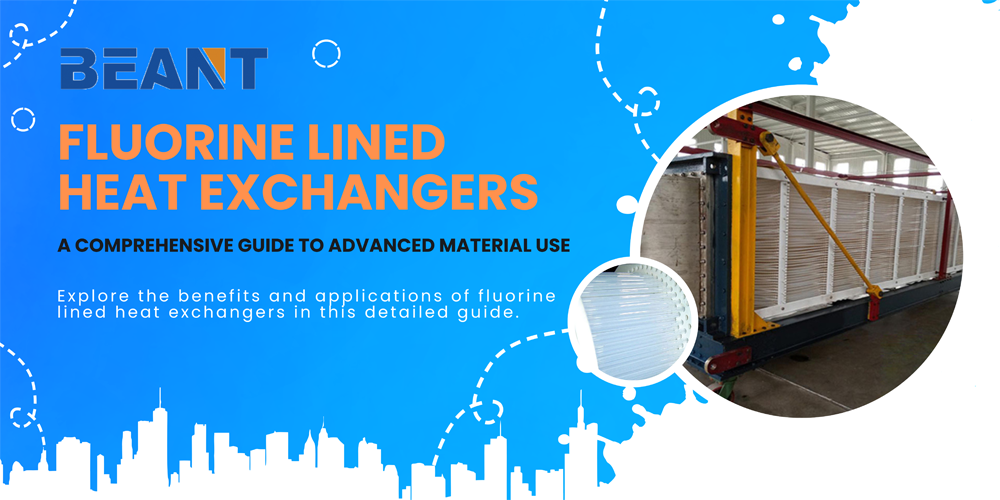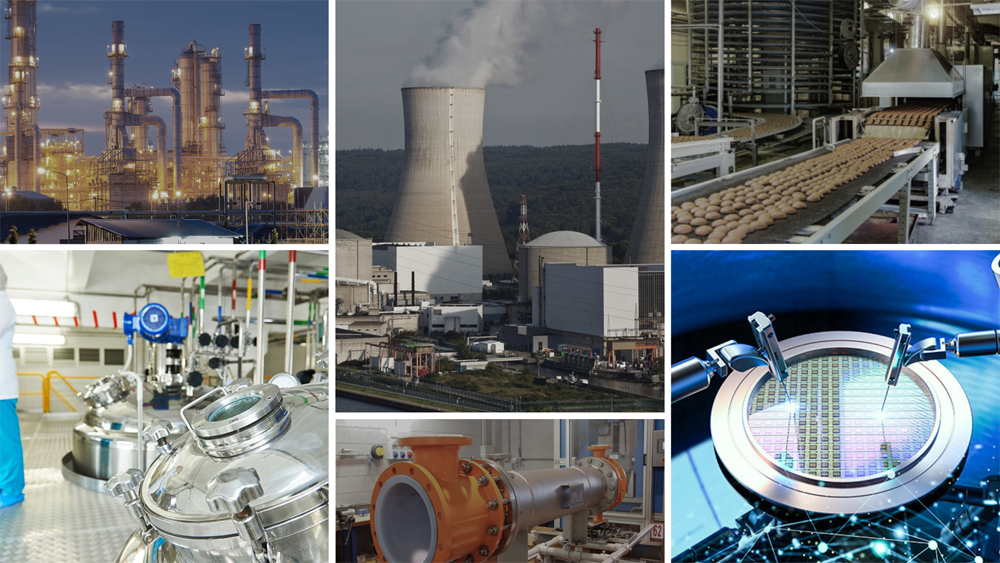
Fluorine lined heat exchangers are engineered to tackle some of the most challenging conditions in industrial processes. These devices are crucial for managing heat transfer between fluids that may be highly corrosive or at extreme temperatures. The linings are typically made from fluoropolymers, which are plastics that contain fluorine molecules renowned for their high resistance to solvents, acids, and bases.
How Fluorine Lined Heat Exchangers Work:Fluorine lined heat exchangers function similarly to traditional heat exchangers but with an added layer of protection. This lining acts as a barrier, preventing the metallic parts of the exchanger from coming into direct contact with aggressive chemicals. Here's a simple breakdown of the process:
Heat Transfer: Fluids at different temperatures flow through the heat exchanger.
Thermal Conductivity: The metal beneath the fluorine lining efficiently conducts heat between the fluids.
Chemical Barrier: The fluorine lining prevents the metal from reacting with corrosive fluids.
Unique Properties of Fluorine:Fluorine's efficacy as a lining material in heat exchangers stems from its exceptional properties:
Chemical Resistance: Fluorine is inert to most chemicals, providing an unmatched barrier against corrosion.
High Temperature Stability: It remains stable under high thermal conditions, which is crucial for heat exchanger applications.
Non-stick Surface: The non-stick nature of fluorine reduces fouling and maintenance needs.
Table 1: Comparison of Fluorine with Other Lining Materials
| Material | Chemical Resistance | Temperature Resistance | Cost |
| Fluorine (PTFE) | Excellent | Up to 260°C | High |
| Rubber Lining | Good | Up to 90°C | Low |
| Stainless Steel | Moderate | Up to 400°C | Moderate |
| Titanium | Very Good | Up to 350°C | Very High |
The use of fluorine linings in heat exchangers provides several key benefits that make them highly sought after in industries dealing with harsh chemicals and extreme temperatures. Below, we explore the major advantages:
One of the primary reasons for choosing fluorine-lined heat exchangers is their exceptional resistance to corrosion. Industries that process aggressive chemicals often face challenges with equipment degradation. Fluorine linings offer a reliable solution, as they do not react with most chemicals, thereby preserving the integrity of the heat exchanger.
The non-reactive nature of fluorine not only protects the equipment but also maintains its efficiency over time. Heat exchangers without proper linings can suffer from scaling and fouling, which reduce thermal efficiency. The smooth surface of fluorine linings minimizes these issues, ensuring consistent performance and reducing downtime for cleaning and maintenance.
Although the initial cost of fluorine lined heat exchangers is higher compared to traditional options, their durability and lower maintenance requirements render them more cost-effective in the long run. This is particularly true in industries where equipment frequently faces chemical exposure and high temperatures.
Table 2: Cost-Benefit Analysis of Fluorine Lined vs. Traditional Heat Exchangers
| Type | Initial Cost | Maintenance Cost | Lifespan | Total Cost of Ownership |
| Fluorine Lined | High | Low | Long | Lower |
| Traditional (No Lining) | Low | High | Short | Higher |
Fluorine lined heat exchangers are invaluable in multiple industrial sectors, particularly where harsh chemicals and extreme temperatures are commonplace. This section highlights some of the key industries and applications that benefit from these advanced materials.

In the chemical processing sector, maintaining the integrity of heat exchangers is crucial due to the corrosive nature of many chemicals processed. Fluorine lined heat exchangers are used extensively to prevent equipment failure and ensure continuous production. They are particularly effective in handling acids, solvents, and other corrosive compounds.
In the pharmaceutical and biotech industries, contamination must be avoided at all costs. Fluorine's inert properties make it an excellent choice for processes that require strict purity standards. Additionally, the easy-to-clean surface helps maintain a sterile environment.
The semiconductor industry requires precise temperature control and contamination-free conditions. Fluorine lined heat exchangers are used for their ability to handle aggressive chemicals used in etching and cleaning processes, while maintaining the purity and quality of the manufacturing environment.
Fluorine lined heat exchangers are also found in the food and beverage industry, where they help in pasteurization processes and maintaining the quality of heat-sensitive products. Their corrosion resistance is beneficial for dealing with acidic food substances and cleaning agents.
These heat exchangers play a crucial role in energy sectors, especially in geothermal and chemical processing plants. Their ability to withstand high temperatures and corrosive fluids makes them suitable for this demanding environment.
Proper installation and maintenance are crucial for maximizing the performance and lifespan of fluorine lined heat exchangers. This section provides key insights into the best practices for installation and routine maintenance to ensure they operate at their optimal capacity.
Environmental Assessment: Before installation, assess the environmental conditions to ensure that the chosen location does not expose the heat exchanger to undue stress, such as extreme temperatures or mechanical vibrations.
Proper Alignment: Ensure all pipes and connections are properly aligned to avoid stress on the heat exchanger, which can lead to premature wear and tear.
Chemical Compatibility: Check all materials in the vicinity for chemical compatibility with fluorine to prevent accidental degradation of the lining.
Routine Inspections: Regular inspections should be conducted to identify any signs of wear or chemical attack early. Special attention should be given to the integrity of the lining.
Cleaning Procedures: Use compatible cleaning agents that do not react with the fluorine lining. Regular cleaning helps maintain efficiency and prevents fouling.
Immediate Repairs: Any damage to the lining should be repaired immediately to prevent corrosive materials from reaching the underlying metal.
Implementing a preventive maintenance schedule that includes periodic checks and routine cleaning can greatly enhance the durability and efficiency of the heat exchanger.
Training for personnel on handling and maintenance procedures to ensure they understand the importance of the lining and how to care for it properly.
Fluorine lined heat exchangers represent a significant advancement in industrial technology, offering unparalleled benefits in terms of efficiency, durability, and chemical resistance. These systems are essential in industries that deal with corrosive materials and high temperatures, providing reliable performance and reducing the need for frequent replacements. The investment in fluorine lining, while initially higher, proves cost-effective over time due to the extended lifespan and reduced maintenance costs.
As industries continue to face challenging environments and stringent efficiency standards, the role of advanced materials like fluorine in heat exchangers becomes increasingly crucial. Future trends may include further enhancements in material technology and even more efficient designs, as the demand for high-performance, durable, and sustainable industrial solutions grows.
Embracing these innovative technologies not only enhances operational capabilities but also supports environmental and economic sustainability. Fluorine lined heat exchangers are a testament to the power of advanced material science in overcoming some of the most demanding industrial challenges.
Feel free to leave your message on our board. If you're looking to inquire about prices or place an order, this is the right place! Let us know the details of your needs, and our team will get back to you with a personalized quote as quickly as possible. We're here to ensure your experience is seamless and satisfactory. Share your requirements or ask any questions you might have - we're eager to assist and look forward to doing business with you!
Name:Tim
Phone:+86-15716151880
Email:[email protected]
Company:BEANT
Address:No. 28, Luoshen Road, Luoshe Town, Huishan District, Wuxi City, Jiangsu Province
